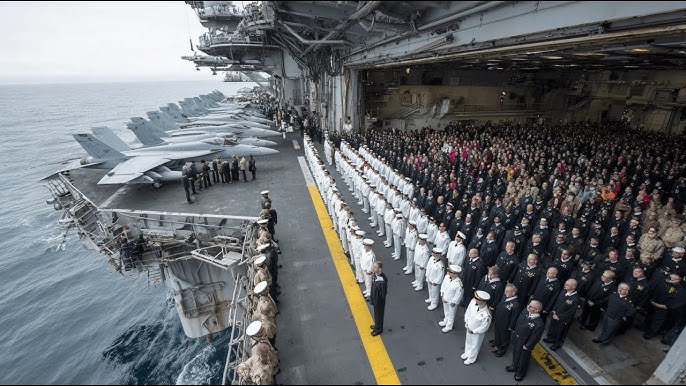US Navy Aircraft Carrier: A Floating City Feeding 5,000 Sailors
 In an astonishing feat of logistics and culinary expertise, the USS Gerald R. Ford, a US Navy aircraft carrier, operates like a self-sufficient city at sea, serving nearly 18,000 meals daily to over 5,000 sailors. This floating fortress, currently deployed above the Arctic Circle with NATO allies, showcases how the Navy sustains its crew in the most challenging environments.
In an astonishing feat of logistics and culinary expertise, the USS Gerald R. Ford, a US Navy aircraft carrier, operates like a self-sufficient city at sea, serving nearly 18,000 meals daily to over 5,000 sailors. This floating fortress, currently deployed above the Arctic Circle with NATO allies, showcases how the Navy sustains its crew in the most challenging environments.

Imagine navigating tight steel corridors filled not only with fighter jets but also bustling galleys, bakeries, and massive cold storage rooms. Each meal prepared is crucial for maintaining the energy levels of sailors tasked with demanding operations, from launching jets to repairing complex machinery. The galleys, often referred to as the heart of the carrier, work around the clock, ensuring that sailors receive essential nutrition and morale-boosting comforts.

Breakfasts can consume an astounding 2,000 eggs in under an hour, while lunch and dinner feature a rotating menu of steaks, pastas, and fresh vegetables. The culinary specialists, trained chefs who work 12-hour shifts, are the backbone of this operation, ensuring that every meal is not just food but a vital part of the crew’s survival.
The logistics of feeding a floating city are nothing short of extraordinary. Underway replenishments, or “unreps,” allow supply ships to transfer pallets of food and supplies while both vessels navigate treacherous seas. This high-stakes ballet of logistics is critical, as a single mistake could mean stretched supplies or spoiled food.

The carrier’s massive refrigerated spaces, known as reefers, are meticulously stocked and monitored. These storage areas hold everything from meat and dairy to fresh fruits, ensuring that sailors have access to a balanced diet throughout their deployment. And when it comes to hydration, the ship produces its own fresh water, distilling seawater to provide hundreds of thousands of gallons daily for drinking, cooking, and even laundry.

Beyond sustenance, the psychological impact of food cannot be overstated. Special meals, like pizza night or steel beach picnics, break the monotony of life at sea, providing sailors with a taste of home. During holidays, the galleys transform, offering elaborate meals that foster camaraderie and boost morale.

Despite the challenges of weather, space limitations, and human fatigue, the system remains resilient. Culinary specialists face long hours in demanding conditions, but their commitment ensures that the mission continues unimpeded. Without food, the machinery of the carrier would grind to a halt, underscoring the critical role of these unsung heroes.

As the USS Gerald R. Ford continues its mission, it serves as a testament to the Navy’s ability to sustain its forces in the most demanding conditions. Feeding 5,000 sailors is not just a logistical challenge; it is a matter of survival, enabling the Navy to maintain its operational readiness and effectiveness in the vast expanse of the ocean.

In the end, the question remains: What comfort food would you miss most if you were deployed for months at sea? The answer is a reminder of the small joys that keep morale high and spirits alive in the relentless grind of life aboard a floating city.





